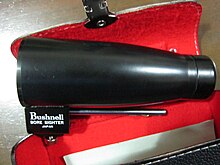
In firearms terminology, an action is the functional mechanism of a breech-loading firearm that handles the ammunition cartridges, or the method by which that mechanism works. Actions are technically not present on muzzleloaders, as all those are single-shot firearms with a closed off breech with the powder and projectile manually loaded from the muzzle. Instead, the muzzleloader ignition mechanism is referred to as the lock.

A collimated beam of light or other electromagnetic radiation has parallel rays, and therefore will spread minimally as it propagates. A laser is an archetypical example. A perfectly collimated light beam, with no divergence, would not disperse with distance. However, diffraction prevents the creation of any such beam.
The Accuracy International Arctic Warfare rifle is a bolt-action sniper rifle designed and manufactured by the British company Accuracy International. It has proved popular as a civilian, police, and military rifle since its introduction in the 1980s. The rifles have features that improve performance in extremely cold conditions without impairing operation in less extreme conditions.
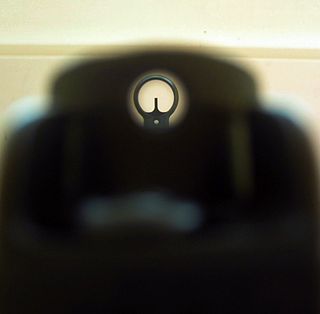
Iron sights are a system of physical alignment markers used as a sighting device to assist the accurate aiming of ranged weapons (such as a firearms, airguns, crossbows, and bows, or less commonly as a primitive finder sight for optical telescopes. Iron sights are the earliest type of sighting device, as it relies completely on the viewer's naked eye, and is distinctly different to optical sights such as telescopic sights, reflector sights, holographic sights, and laser sights, which make use of optical manipulation and/or active illumination.
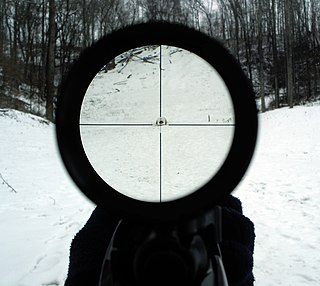
A telescopic sight, commonly called a scope informally, is an optical sighting device based on a refracting telescope. It is equipped with some form of a referencing pattern – known as a reticle – mounted in a focally appropriate position in its optical system to provide an accurate point of aim. Telescopic sights are used with all types of systems that require magnification in addition to reliable visual aiming, as opposed to non-magnifying iron sights, reflector (reflex) sights, holographic sights or laser sights, and are most commonly found on long-barrel firearms, particularly rifles, usually via a scope mount. Similar devices are also found on other platforms such as artillery, tanks and even aircraft. The optical components may be combined with optoelectronics to add night vision or smart device features.

The FN F2000 is a 5.56×45mm NATO bullpup rifle, designed by FN Herstal in Belgium. Its compact bullpup design includes a telescopic sight, a non-adjustable fixed notch and front blade secondary sight. The weapon has fully ambidextrous controls, allowed by a unique ejection system, ejecting spent cartridge casings forward and to the right side of the weapon, through a tube running above the barrel. The F2000 made its debut in March 2001 at the IDEX defence exhibition held in Abu Dhabi, in the United Arab Emirates.
A collimator is a device which narrows a beam of particles or waves. To narrow can mean either to cause the directions of motion to become more aligned in a specific direction, or to cause the spatial cross section of the beam to become smaller.
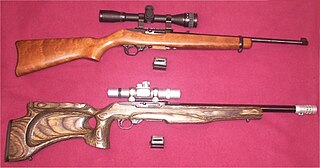
Accurizing is the process of improving the accuracy and precision of a gun.

A sight or sighting device is any device used to assist in precise visual alignment of weapons, surveying instruments, aircraft equipment, optical illumination equipment or larger optical instruments with the intended target. Sights can be a simple set or system of physical markers that serve as visual references for directly aligning the user's line of sight with the target, or optical instruments that provide an optically enhanced—often magnified—target image aligned in the same focus with an aiming point. There are also sights that actively project an illuminated point of aim onto the target itself so it can be observed by anyone with a direct view, such as laser sights and infrared illuminators on some night vision devices, as well as augmented or even virtual reality-enabled digital cameras with software algorithms that produce digitally enhanced target images.
The Karabiner Modell 1931 is a magazine-fed, straight-pull bolt-action rifle. It was the standard-issue rifle of the Swiss armed forces from 1933 until 1958 though examples remained in service into the 1970s. It has a 6-round removable magazine, and is chambered for the 7.5×55mm Swiss Gewehrpatrone 1911 or GP 11, a cartridge with ballistic qualities similar to the 7.62×51mm NATO/.308 Winchester cartridge. Each rifle included a 6-round detachable box magazine with matching stamped serial number. A stripper clip can be used to load the magazine from the top of the receiver.

An autocollimator is an optical instrument for non-contact measurement of angles. They are typically used to align components and measure deflections in optical or mechanical systems. An autocollimator works by projecting an image onto a target mirror and measuring the deflection of the returned image against a scale, either visually or by means of an electronic detector. A visual autocollimator can measure angles as small as 1 arcsecond, while an electronic autocollimator can have up to 100 times more resolution.

The Heckler & KochG41 is a German 5.56×45mm NATO assault rifle introduced in 1981 and produced in limited quantities by Heckler & Koch. It was designed to replace the 7.62×51mm NATO chambered Heckler & Koch G3 and the G3 based .223 Remington/5.56×45mm and later 5.56×45mm NATO chambered Heckler & Koch HK33 service rifles providing a more modern weapon compatible with then recently introduced NATO standards. It can use both the then new STANAG 4172 compliant 5.56×45mm NATO SS109, SS110, and SS111 ammunition and older .223 Remington/5.56×45mm M193 ammunition and was the last Heckler & Koch service rifle designed around the roller-delayed blowback mechanism.
The following are terms related to firearms and ammunition topics.

The APR is a bolt-action sniper rifle designed by the Thun-based Brügger & Thomet in 2003 as an evolution of the French PGM Précision.

A red dot sight is a common classification for a non-magnifying reflector sight that provides an illuminated red dot to the user as a point of aim. A standard design uses a red light-emitting diode (LED) at the focus of collimating optics, which generates a dot-style illuminated reticle that stays in alignment with the firearm the sight is attached to, regardless of eye position.
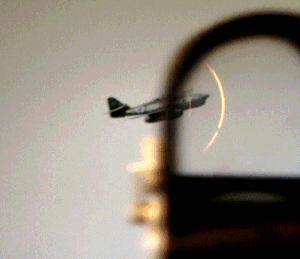
A reflector sight or reflex sight is an optical sight that allows the user to look through a partially reflecting glass element and see an illuminated projection of an aiming point or some other image superimposed on the field of view. These sights work on the simple optical principle that anything at the focus of a lens or curved mirror will appear to be sitting in front of the viewer at infinity. Reflector sights employ some form of "reflector" to allow the viewer to see the infinity image and the field of view at the same time, either by bouncing the image created by lens off a slanted glass plate, or by using a mostly clear curved glass reflector that images the reticle while the viewer looks through the reflector. Since the reticle is at infinity it stays in alignment with the device to which the sight is attached regardless of the viewer's eye position, removing most of the parallax and other sighting errors found in simple sighting devices.
The bore axis of a firearm is the longitudinal axis through the geometric center of the gun barrel. In a rifled barrel, the projectile will spin around the bore axis as it goes through the barrel.

A laser sight is a device attached or integral to a firearm to aid target acquisition. Unlike optical and iron sights where the user looks through the device to aim at the target, laser sights project a beam onto the target, providing a visual reference point.
